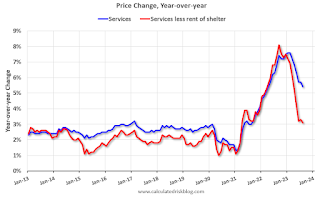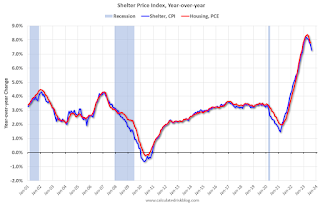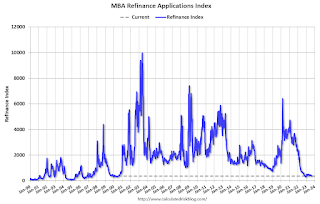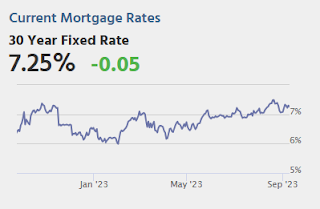by Calculated Risk on 9/14/2023 08:30:00 AM
Thursday, September 14, 2023
Weekly Initial Unemployment Claims Increase to 220,000
The DOL reported:
In the week ending September 9, the advance figure for seasonally adjusted initial claims was 220,000, an increase of 3,000 from the previous week's revised level. The previous week's level was revised up by 1,000 from 216,000 to 217,000. The 4-week moving average was 224,500, a decrease of 5,000 from the previous week's revised average. The previous week's average was revised up by 250 from 229,250 to 229,500.The following graph shows the 4-week moving average of weekly claims since 1971.
emphasis added
 Click on graph for larger image.
Click on graph for larger image.The dashed line on the graph is the current 4-week average. The four-week average of weekly unemployment claims decreased to 224,500.
The previous week was revised up.
Weekly claims were higher than the consensus forecast.
Wednesday, September 13, 2023
Thursday: Retail Sales, Unemployment Claims, PPI
by Calculated Risk on 9/13/2023 08:00:00 PM

Thursday:
• At 8:30 AM ET, The initial weekly unemployment claims report will be released. The consensus is for 212 thousand initial claims, down from 216 thousand last week.
• Also at 8:30 AM, Retail sales for August will be released. The consensus is for a 0.1% increase in retail sales.
• Also at 8:30 AM, The Producer Price Index for August from the BLS. The consensus is for a 0.4% decrease in PPI, and a 0.2% increase in core PPI.
Early Look at 2024 Cost-Of-Living Adjustments and Maximum Contribution Base
by Calculated Risk on 9/13/2023 02:43:00 PM
The BLS reported on this morning:
The Consumer Price Index for Urban Wage Earners and Clerical Workers (CPI-W) increased 3.4 percent over the last 12 months to an index level of 301.551 (1982-84=100). For the month, the index increased 0.6 percent prior to seasonal adjustment.CPI-W is the index that is used to calculate the Cost-Of-Living Adjustments (COLA). The calculation dates have changed over time (see Cost-of-Living Adjustments), but the current calculation uses the average CPI-W for the three months in Q3 (July, August, September) and compares to the average for the highest previous average of Q3 months. Note: this is not the headline CPI-U and is not seasonally adjusted (NSA).
• In 2022, the Q3 average of CPI-W was 291.901.
The 2022 Q3 average was the highest previous Q3 average, so we only have to compare Q3 this year to last year.
 Click on graph for larger image.
Click on graph for larger image.This graph shows CPI-W since January 2000. The red lines are the Q3 average of CPI-W for each year.
Note: The year labeled is for the calculation, and the adjustment is effective for December of that year (received by beneficiaries in January of the following year).
CPI-W was up 3.4% year-over-year in August, and although this is early - we need the data for September - my early guess is COLA will probably be close to 3.2% this year, the smallest increase since 1.3% in 2021.
Contribution and Benefit Base
The contribution base will be adjusted using the National Average Wage Index. This is based on a one-year lag. The National Average Wage Index is not available for 2022 yet, wages increased solidly in 2022. If wages increased 5% in 2022, then the contribution base next year will increase to around $168,200 in 2024, from the current $160,200.
Remember - this is an early look. What matters is average CPI-W, NSA, for all three months in Q3 (July, August and September).
Part 1: Current State of the Housing Market; Overview for mid-September
by Calculated Risk on 9/13/2023 11:36:00 AM
Today, in the Calculated Risk Real Estate Newsletter: Part 1: Current State of the Housing Market; Overview for mid-September
A brief excerpt:
Interestingly, new home inventory is close to a record percentage of total inventory. This graph uses Not Seasonally Adjusted (NSA) existing home inventory from the National Association of Realtors® (NAR) and new home inventory from the Census Bureau (only completed and under construction inventory).There is much more in the article. You can subscribe at https://calculatedrisk.substack.com/
Note: Mark Fleming, Chief Economist at First American pointed this out in March.
It took a number of years following the housing bust for new home inventory to return to the pre-bubble percent of total inventory. Then, with the pandemic, existing home inventory collapsed and now the percent of new homes is close to 23% of total for sale inventory. The lack of existing home inventory, and few distressed sales, has been a positive for homebuilders.
YoY Measures of Inflation: Services, Goods and Shelter
by Calculated Risk on 9/13/2023 08:55:00 AM
Here are a few measures of inflation:
The first graph is the one Fed Chair Powell had mentioned earlier when services less rent of shelter was up 7.6% year-over-year. This has fallen sharply and is now up 3.1% YoY.

This graph shows the YoY price change for Services and Services less rent of shelter through July 2023.
Services less rent of shelter was up 3.1% YoY in August, down from 3.3% YoY in July.
 The second graph shows that goods prices started to increase year-over-year (YoY) in 2020 and accelerated in 2021 due to both strong demand and supply chain disruptions.
The second graph shows that goods prices started to increase year-over-year (YoY) in 2020 and accelerated in 2021 due to both strong demand and supply chain disruptions.Commodities less food and energy commodities were up 0.4% YoY in August, down from 0.9% YoY in July.
 Here is a graph of the year-over-year change in shelter from the CPI report (through August) and housing from the PCE report (through July 2023)
Here is a graph of the year-over-year change in shelter from the CPI report (through August) and housing from the PCE report (through July 2023)Shelter was up 7.2% year-over-year in August, down from 7.7% in July. Housing (PCE) was up 7.8% YoY in July, down from 8.0% in June.
The BLS noted this morning: "The index for gasoline was the largest contributor to the monthly all items increase, accounting for over half of the increase. Also contributing to the August monthly increase was continued advancement in the shelter index, which rose for the 40th consecutive month."
BLS: CPI increased 0.6% in August; Core CPI increased 0.3%
by Calculated Risk on 9/13/2023 08:32:00 AM
The Consumer Price Index for All Urban Consumers (CPI-U) rose 0.6 percent in August on a seasonally adjusted basis, after increasing 0.2 percent in July, the U.S. Bureau of Labor Statistics reported today. Over the last 12 months, the all items index increased 3.7 percent before seasonal adjustment.CPI and core CPI were close to expectations. I'll post a graph later today after the Cleveland Fed releases the median and trimmed-mean CPI.
The index for gasoline was the largest contributor to the monthly all items increase, accounting for over half of the increase. Also contributing to the August monthly increase was continued advancement in the shelter index, which rose for the 40th consecutive month. The energy index rose 5.6 percent in August as all the major energy component indexes increased. The food index increased 0.2 percent in August, as it did in July. The index for food at home increased 0.2 percent over the month while the index for food away from home rose 0.3 percent in August.
The index for all items less food and energy rose 0.3 percent in August, following a 0.2-percent increase in July. Indexes which increased in August include rent, owners' equivalent rent, motor vehicle insurance, medical care, and personal care. The indexes for lodging away from home, used cars and trucks, and recreation were among those that decreased over the month.
The all items index increased 3.7 percent for the 12 months ending August, a larger increase than the 3.2-percent increase for the 12 months ending in July. The all items less food and energy index rose 4.3 percent over the last 12 months. The energy index decreased 3.6 percent for the 12 months ending August, and the food index increased 4.3 percent over the last year.
emphasis added
MBA: Mortgage Applications Decreased in Weekly Survey
by Calculated Risk on 9/13/2023 07:00:00 AM
From the MBA: Mortgage Applications Decrease in Latest MBA Weekly Survey
Mortgage applications decreased 0.8 percent from one week earlier, according to data from the Mortgage Bankers Association’s (MBA) Weekly Mortgage Applications Survey for the week ending September 8, 2023. This week’s results included an adjustment for the Labor Day holiday.
The Market Composite Index, a measure of mortgage loan application volume, decreased 0.8 percent on a seasonally adjusted basis from one week earlier. On an unadjusted basis, the Index decreased 12 percent compared with the previous week. The Refinance Index decreased 5 percent from the previous week and was 31 percent lower than the same week one year ago. The seasonally adjusted Purchase Index increased 1 percent from one week earlier. The unadjusted Purchase Index decreased 11 percent compared with the previous week and was 27 percent lower than the same week one year ago.
“Mortgage applications decreased for the seventh time in eight weeks, reaching the lowest level since 1996. Last week’s decline was driven by a 5 percent drop in refinance applications to the weakest reading since January 2023,” said Joel Kan, MBA’s Vice President and Deputy Chief Economist. “The 30-year fixed mortgage rate increased to 7.27 percent last week and was 40 basis points higher than where it was in late July. Purchase applications increased over the week despite the increase in rates, pushed higher by a 2 percent gain in conventional loans. Given how high rates are right now, there continues to be minimal refinance activity and a reduced incentive for homeowners to sell and buy a new home at a higher rate.”
...
The average contract interest rate for 30-year fixed-rate mortgages with conforming loan balances ($726,200 or less) increased to 7.27 percent from 7.21 percent, with points increasing to 0.72 from 0.69 (including the origination fee) for 80 percent loan-to-value ratio (LTV) loans.
emphasis added
 Click on graph for larger image.
Click on graph for larger image.The first graph shows the MBA mortgage purchase index.
According to the MBA, purchase activity is down 27% year-over-year unadjusted.

Tuesday, September 12, 2023
Wednesday: CPI
by Calculated Risk on 9/12/2023 07:51:00 PM

Mortgage rates are noticeably higher to start the new week for most lenders although some lenders increased their costs nearly as much on Friday. Between the two business days (banks were closed on Monday), the average lender is up between 0.125% and 0.25% from Thursday afternoon. [30 year fixed 7.21%]Wednesday:
emphasis added
• At 7:00 AM ET, The Mortgage Bankers Association (MBA) will release the results for the mortgage purchase applications index.
• At 8:30 AM, The Consumer Price Index for August from the BLS. The consensus is for a 0.6% increase in CPI, and a 0.2% increase in core CPI. The consensus is for CPI to be up 3.6% year-over-year and core CPI to be up 4.3% YoY.
CPI Preview and Owners' equivalent rent
by Calculated Risk on 9/12/2023 02:31:00 PM
Tomorrow the BLS will release inflation data for August. The consensus is for a 0.6% increase in CPI, and a 0.2% increase in core CPI. The consensus is for CPI to be up 3.6% year-over-year (up from 3.3% in July) and core CPI to be up 4.3% YoY (down from 4.7% in July).
Here is a preview from Goldman Sachs economists Manuel Abecasis and Spencer Hill:
We expect a 0.24% increase in August core CPI (vs. 0.2% consensus), corresponding to a year-over-year rate of 4.30% (vs. 4.3% consensus). We expect a 0.63% increase in August headline CPI (vs. 0.6% consensus), which corresponds to a year-over-year rate of 3.58% (vs. 3.6% consensus).A key component to watch is the year-over-year change in shelter. Asking rents are mostly flat year-over-year, but renewals are still increasing - and this has kept the BLS measure of shelter inflation from falling faster.
Last month the BLS noted: "The index for shelter was by far the largest contributor to the monthly all items increase, accounting for over 90 percent of the increase, with the index for motor vehicle insurance also contributing."
 Here is a graph of the year-over-year change in shelter from the CPI report (through July) and housing from the PCE report (through June 2023)
Here is a graph of the year-over-year change in shelter from the CPI report (through July) and housing from the PCE report (through June 2023)Shelter was up 7.7% year-over-year in July, down from 7.8% in June. Housing (PCE) was up 8.0% YoY in June, down from 8.3% in May.
2nd Look at Local Housing Markets in August
by Calculated Risk on 9/12/2023 10:08:00 AM
Today, in the Calculated Risk Real Estate Newsletter: 2nd Look at Local Housing Markets in August
A brief excerpt:
This is the second look at local markets in August. I’m tracking a sample of about 40 local housing markets in the US. Some of the 40 markets are states, and some are metropolitan areas. I’ll update these tables throughout the month as additional data is released.There is much more in the article. You can subscribe at https://calculatedrisk.substack.com/
Closed sales in August were mostly for contracts signed in June and July. Since 30-year fixed mortgage rates were in the 6.7% range in June, and 6.8% in July, compared to the mid-5% range the previous year, closed sales were down year-over-year in August.
...
In August, sales in these markets were down 12.8%. In July, these same markets were down 13.7% YoY Not Seasonally Adjusted (NSA).
This is a slightly smaller YoY decline NSA than in July for these early reporting markets. Note that there were the same number of selling days each year in August 2022 and August 2023. ... This early data suggests the August existing home sales report will show another significant YoY decline - and probably close to or below the July sales rate of 4.07 million (SAAR) - and the 24th consecutive month with a YoY decline in sales.
Many more local markets to come!


